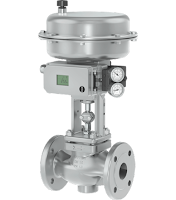Pneumatic valve actuators are used in extreme conditions in many industries such as oil and gas, chemical, water and wastewater, bulk storage, pulp & paper, and power generation. These devices are used in a multitude of valve control processes for regulation (or cessation) of flow, controlling pressure and adjusting level. Due to their reliability and simplicity, pneumatic actuators are one of the most popular types of actuators used in industry today.
Pneumatic valve actuators work by conversion of air pressure into motion. The device applies a force of air to a diaphragm, rotary vane, or piston that is attached to the actuator shaft, which is then mechanically connected to the stem of the valve or damper. Depending on the type, pneumatic actuators produce either linear or rotary motion.
ACTUATOR ACTION - SPRING RETURN OR DOUBLE ACTING
Spring Return — Pneumatic actuators with spring return design have air supplied from one side. The spring on the opposite side is responsible for the motion. With this design, air compression moves the opens or shuts the valves while the spring is responsible for the opposite motion.
Double Acting — Double acting actuators have air fed on both sides of a piston. The pressure on one side is higher as compared to the other that results in the required in movement. Air is used to open and close the valves.
PNEUMATIC ACTUATOR DESIGNS
Diaphragm Actuators — Diaphragm actuators work by applying pressure to a thin membrane or diaphragm.
Piston Actuators — Piston actuators apply compress air to a piston that is within a cylinder. Air is fed into a chamber that moves the piston in one direction. The piston moves in the opposite direction when air pressure is removed (spring assisted) or directed to the other side (double acting).
Rack and Pinion — Rack and pinion actuators produce rotation by applying pressure to pistons with gears that turn a pinion gear. Rack and pinion actuators can be spring return or double acting. They are valued because of their compact size and versatility.
Scotch Yoke — A scotch-yoke actuator contains a piston, yoke, connecting shaft, and rotary pin.
They can be direct acting or spring return. They are capable of providing very high torque outputs and are generally used on larger valves. Scotch yoke actuators can be powered by air or process gas.
Rotary Vane —Vane actuators use a mechanical vane, connected to a shaft, that separates a circular shaped body in two "clamshell" halves. The vane moves in response to the differential pressure inside the actuator body, turning the shaft clockwise or counter-clockwise in response to the pressure differential. External springs units are available for spring return models.
BENEFITS OF PNEUMATIC ACTUATORS
The use of compressed air (typically found in all industrial facilities) as the power source is the prime advantage for the use of pneumatic actuators. Additionally, pneumatic actuators have an advantage in suitability for different environments and can be used in extremes temperatures. They are preferred over electrical actuators in explosive, flammable and other hazardous areas because they do not require electricity (a possible ignition source) to operate. They do not create electrical fields or electrical noise since there is no electrical motor. Pneumatic valve actuators are faster opening and closing compared to their electric counterparts. Finally, they are low cost, lightweight, durable, require little maintenance (depending on quality) and there are a myriad of positioning controls, speed controls, and communications devices available for tailoring the actuator to the application.
DRAWBACKS OF PNEUMATIC ACTUATORS
While compressed air is the main reason for using pneumatic actuators, it can also be considered a drawback. For instance, pneumatic actuators can perform poorly when the air supply source is located at a distance, resulting in lag and slow response. Another drawback of pneumatic actuators is the additional cost for the compressed air system due to the requirement of dust filters and moisture removing dryers. These are required to ensure clean air is fed into the system.
APPLYING PNEUMATIC ACTUATORS
There are many aspects to the proper, safe, and efficient application of pneumatic actuators to valves and dampers. Sizing the power output (torque) being paramount. All valves and dampers have unique torque requirements. You must consider a threshold force for opening (breakaway), as the valve continues to move to its open or closed position, and then for seating. Matching the actuators to the valve type, and operating conditions is critical. Published torque curves must be reviewed and understood. Too little torque and the vale will not respond. Too much torque increases cost and can damage the valve. Spring return adds to this complexity. Considering all this, it is
strongly suggested you always discuss any valve actuation requirement with an experienced applications expert. They will ensure the proper, safe, and cost effective mating of pneumatic actuator to valve or damper.













